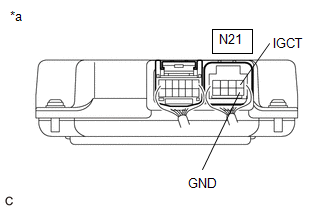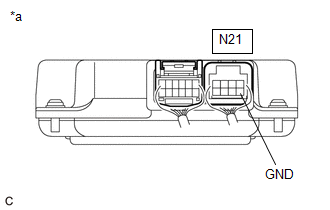Lexus ES: Hybrid/EV Battery Sensor Module (P0AFC00,P0AFC16,P0AFC96,P308A12)
DESCRIPTION
If the battery voltage sensor detects an internal malfunction, it sends an error signal to the hybrid vehicle control ECU. When the hybrid vehicle control ECU receives the error signal from the battery voltage sensor, the ECU warns the driver and performs fail-safe control.
| DTC No. | Detection Item | DTC Detection Condition | Trouble Area | MIL | Warning Indicate |
|---|---|---|---|---|---|
| P0AFC00 | Hybrid/EV Battery Sensor Module | The hybrid vehicle control ECU receives an error signal from the battery voltage sensor. (1 trip detection logic) |
| Comes on | Master Warning Light: Comes on |
| P0AFC16 | Hybrid/EV Battery Sensor Module Circuit Voltage Below Threshold | The hybrid vehicle control ECU receives an error signal from the battery voltage sensor. (1 trip detection logic) |
| Comes on | Master Warning Light: Comes on |
| P0AFC96 | Hybrid/EV Battery Sensor Module Component Internal Failure | The hybrid vehicle control ECU receives an error signal from the battery voltage sensor. (1 trip detection logic) |
| Comes on | Master Warning Light: Comes on |
| P308A12 | Hybrid/EV Battery Voltage Sensor All Circuit Short to Auxiliary Battery | The hybrid vehicle control ECU receives an error signal from the battery voltage sensor. (1 trip detection logic) |
| Comes on | Master Warning Light: Comes on |
| DTC No. | Data List |
|---|---|
| P0AFC00 | Hybrid Battery Sensor Module Power Supply Voltage |
| P0AFC16 | |
| P0AFC96 | |
| P308A12 |
MONITOR DESCRIPTION
If the battery voltage sensor detects an internal malfunction in the unit itself, the hybrid vehicle control ECU will illuminate the MIL and store a DTC.
MONITOR STRATEGY
| Related DTCs | P0AFC (INF P0AFC00/P0AFC16/P0AFC96), P308D (INF P308A12): Hybrid Battery Pack Sensor Module |
| Required sensors/components | Battery voltage sensor |
| Frequency of operation | Continuous |
| Duration | TMC's intellectual property |
| MIL operation | Immediately |
| Sequence of operation | None |
TYPICAL ENABLING CONDITIONS
| The monitor will run whenever the following DTCs are not stored | TMC's intellectual property |
| Other conditions belong to TMC's intellectual property | - |
TYPICAL MALFUNCTION THRESHOLDS
| TMC's intellectual property | - |
COMPONENT OPERATING RANGE
| Battery voltage sensor | DTC P0AFC (INF P0AFC00/P0AFC16/P0AFC96) is not detected DTC P308D (INF P308A12) is not detected |
CONFIRMATION DRIVING PATTERN
HINT:
-
After repair has been completed, clear the DTC and then check that the vehicle has returned to normal by performing the following All Readiness check procedure.
Click here
.gif)
-
When clearing the permanent DTCs, refer to the "CLEAR PERMANENT DTC" procedure.
Click here
.gif)
- Connect the Techstream to the DLC3.
- Turn the power switch on (IG) and turn the Techstream on.
- Clear the DTCs (even if no DTCs are stored, perform the clear DTC procedure).
- Turn the power switch off and wait for 2 minutes or more.
- Turn the power switch on (IG) and turn the Techstream on.
-
With power switch on (IG) and wait for 10 seconds or more.[*1]
HINT:
[*1]: Normal judgment procedure.
The normal judgment procedure is used to complete DTC judgment and also used when clearing permanent DTCs.
- Enter the following menus: Powertrain / Hybrid Control / Utility / All Readiness.
-
Check the DTC judgment result.
HINT:
- If the judgment result shows NORMAL, the system is normal.
- If the judgment result shows ABNORMAL, the system has a malfunction.
- If the judgment result shows INCOMPLETE or N/A, perform the normal judgment procedure again.
WIRING DIAGRAM
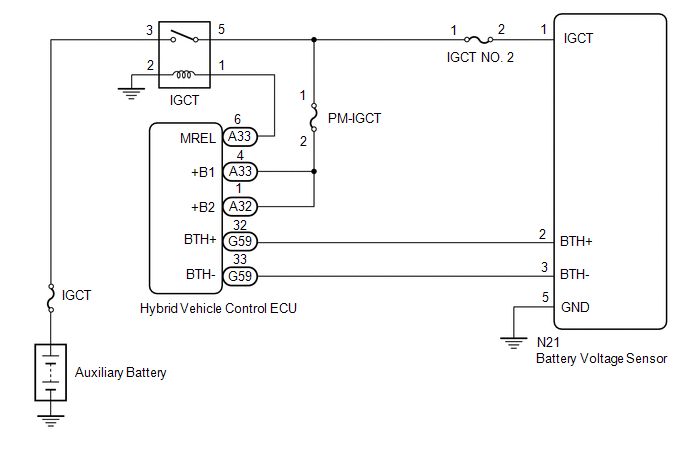
CAUTION / NOTICE / HINT
CAUTION:
-
Before the following operations are conducted, take precautions to prevent electric shock by turning the power switch off, wearing insulated gloves, and removing the service plug grip from HV battery.
.png)
- Inspecting the high-voltage system
- Disconnecting the low voltage connector of the inverter with converter assembly
- Disconnecting the low voltage connector of the HV battery
-
To prevent electric shock, make sure to remove the service plug grip to cut off the high voltage circuit before servicing the vehicle.
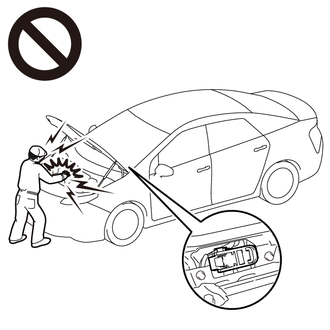
-
After removing the service plug grip from the HV battery, put it in your pocket to prevent other technicians from accidentally reconnecting it while you are working on the high-voltage system.
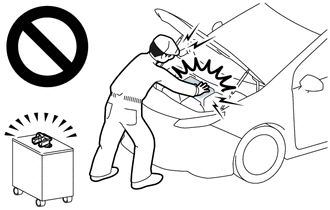
-
After removing the service plug grip, wait for at least 10 minutes before touching any of the high-voltage connectors or terminals. After waiting for 10 minutes, check the voltage at the terminals in the inspection point in the inverter with converter assembly. The voltage should be 0 V before beginning work.
Click here
.gif)
HINT:
Waiting for at least 10 minutes is required to discharge the high-voltage capacitor inside the inverter with converter assembly.

*a
Without waiting for 10 minutes
NOTICE:
After turning the power switch off, waiting time may be required before disconnecting the cable from the negative (-) auxiliary battery terminal. Therefore, make sure to read the disconnecting the cable from the negative (-) auxiliary battery terminal notices before proceeding with work.
Click here .gif)
.gif)
.gif)
.gif)
PROCEDURE
| 1. | CHECK CONNECTOR CONNECTION CONDITION (BATTERY VOLTAGE SENSOR CONNECTOR) |
CAUTION:
Be sure to wear insulated gloves.
(a) Check that the service plug grip is not installed.
NOTICE:
After removing the service plug grip, do not turn the power switch on (READY), unless instructed by the repair manual because this may cause a malfunction.
(b) Remove the No. 1 hybrid battery exhaust duct.
Click here .gif)
.gif)
| (c) Check the connections of the battery voltage sensor connector. Click here OK: The connector is connected securely and there are no contact problems. |
|
(d) Remove the No. 1 HV battery shield panel.
Click here .gif)
.gif)
| (e) Check the connections of the battery voltage sensor connector. Click here OK: The connector is connected securely and there are no contact problems. |
|
(f) Install the No. 1 HV battery shield panel.
(g) Install the No. 1 hybrid battery exhaust duct.
| NG | .gif) | CONNECT SECURELY |
|
| 2. | CHECK HARNESS AND CONNECTOR (IGCT VOLTAGE) |
CAUTION:
Be sure to wear insulated gloves.
(a) Check that the service plug grip is not installed.
NOTICE:
- Check and record any DTCs, INF codes and freeze frame data, then disconnect the cable from the negative (-) auxiliary battery terminal.
- After removing the service plug grip, do not turn the power switch on (READY), unless instructed by the repair manual because this may cause a malfunction.
(b) Remove the No. 1 hybrid battery exhaust duct.
Click here .gif)
.gif)
(c) Connect the cable to the negative (-) auxiliary battery terminal.
(d) Turn the power switch on (IG).
| (e) Measure the voltage according to the value(s) in the table below. Standard Voltage:
NOTICE: Turning the power switch on (IG) with the service plug grip removed causes other DTCs to be stored. Clear the DTCs after performing this inspection. |
|
(f) Turn the power switch off.
(g) Disconnect the cable from the negative (-) auxiliary battery terminal.
(h) Install the No. 1 hybrid battery exhaust duct.
| OK | .gif) | REPLACE BATTERY VOLTAGE SENSOR |
|
| 3. | CHECK HARNESS AND CONNECTOR (BATTERY VOLTAGE SENSOR - BODY GROUND) |
CAUTION:
Be sure to wear insulated gloves.
(a) Check that the service plug grip is not installed.
NOTICE:
After removing the service plug grip, do not turn the power switch on (READY), unless instructed by the repair manual because this may cause a malfunction.
(b) Remove the No. 1 hybrid battery exhaust duct.
Click here .gif)
.gif)
| (c) Measure the resistance according to the value(s) in the table below. Standard Resistance:
|
|
(d) Install the No. 1 hybrid battery exhaust duct.
| OK | .gif) | REPAIR OR REPLACE HARNESS OR CONNECTOR (IGCT NO. 2 FUSE - BATTERY VOLTAGE SENSOR) |
| NG | .gif) | REPAIR OR REPLACE HARNESS OR CONNECTOR (BATTERY VOLTAGE SENSOR - BODY GROUND) |

.png)
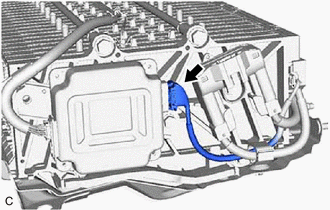
.gif)
